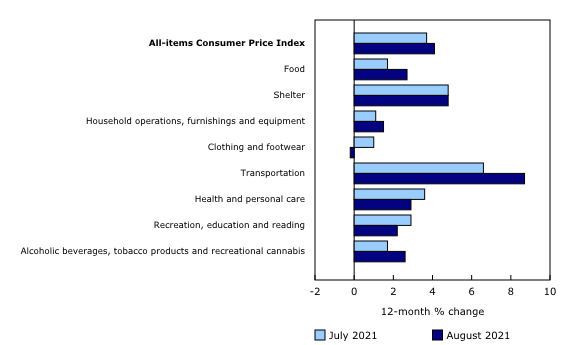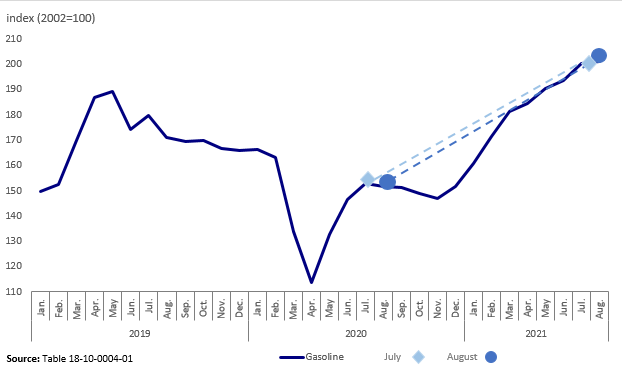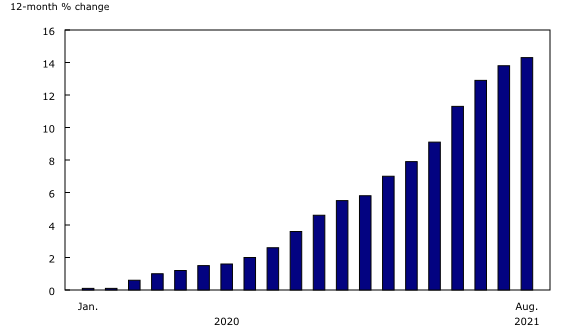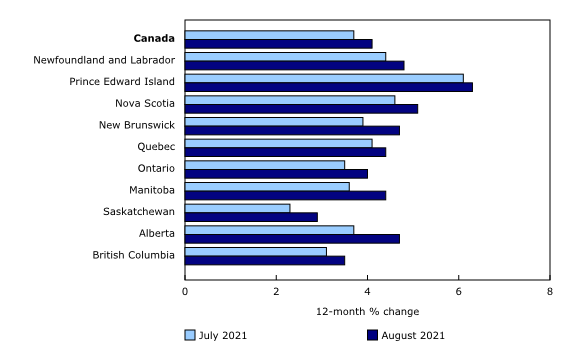Consumer Price Index, August 2021
Archived Content
Information identified as archived is provided for reference, research or recordkeeping purposes. It is not subject to the Government of Canada Web Standards and has not been altered or updated since it was archived. Please "contact us" to request a format other than those available.
Released: 2021-09-15
August 2021
4.1% 
(12-month change)
The Consumer Price Index (CPI) rose 4.1% on a year-over-year basis in August, the fastest pace since March 2003, up from a 3.7% gain in July. The increase in prices mainly stems from an accumulation of recent price pressures and from lower price levels in 2020. Excluding gasoline, the CPI rose 3.2% year over year.
The monthly CPI rose 0.2% in August, down from a 0.6% increase in July. On a seasonally adjusted monthly basis, the CPI rose 0.4%.
Highlights
Since the onset of the COVID-19 pandemic, durable goods have been a major contributor to the increase in the CPI. Durable goods rose at a faster pace in August (+5.7%) compared with July (+5.0%), with passenger vehicles (+7.2%), furniture (+8.7%) and household appliances (+5.3%) contributing the most to the increase.
In addition, prices for services have accelerated for the fifth consecutive month, rising at a faster pace in August (+2.7%) compared with July (+2.6%) amid easing of COVID-19 restrictions. Year over year, prices for traveller accommodation rose 19.3%. Reopening of businesses and summer travel contributed to the price increases.
Prices rose in seven of the eight major components in August, with transportation prices contributing the most to the all-items increase. Conversely, consumers paid less for clothing and footwear, as prices declined year over year.
Gasoline prices rise in August
Year over year, gasoline prices rose 32.5% in August, mainly driven by lower production from oil-producing countries compared with pre-pandemic levels. Also contributing to the year-over-year increase were the low price levels observed in August 2020.
Gasoline prices rose 0.4% month over month in August. Upward pressure on prices near the end of the month—as some offshore production was suspended due to Hurricane Ida—was partially offset by slowing global demand due to concerns associated with the rise of the Delta variant of COVID-19.
Homeowners' replacement cost index rises at the fastest pace in more than three decades
The homeowners' replacement cost index, which is related to the price of new homes, continued to trend upward, rising 14.3% year over year in August—the largest yearly increase since September 1987. This was the fourth consecutive month of double-digit price growth.
Similarly, the other owned accommodation expenses index, which includes commission fees on the sale of real estate, rose 14.3% year over year in August.
Spotlight on the digital economy
The rise of the digital economy has altered the consumption patterns of Canadians, as more goods and services can be purchased and consumed online. From 2018 to 2020, online spending rose by almost half, as online shopping and new digital goods and services became more popular.
To gain additional insight into prices related to the digital economy, a special aggregate price index for digital economy services was published with the release of the August 2021 CPI. The special aggregate comprises consumer prices for cellular services, parcel post services, Internet access services, ride sharing, broadcasting distribution services, video streaming services and audio streaming services. The price series is available back to January 2019 and is published at the national level. On a year-over-year basis, prices for digital economy services fell 4.8%, mainly driven by lower prices for cellular services (-18.9%).
Over the course of the COVID-19 pandemic, the popularity of consuming digital goods and services increased. Many stores and businesses were temporarily closed to curb the spread of the virus, leading consumers toward more online shopping. In addition, as Canadians spent more time at home, consumption of online entertainment activities, such as streaming video content online, increased. The video and audio subscription services index, which includes video streaming services, rose 5.8% year over year in August.
As the digital economy evolves, Statistics Canada will continue to monitor and incorporate new goods and services in order to maintain relevance and reflect changes in consumer spending.
Traveller accommodation prices increase in August
The traveller accommodation price index rose 19.3% year over year in August. Prices accelerated in every province, as travel restrictions eased and demand for travel increased. Prices rose the most in British Columbia (+26.9%), but price increases were also seen in Newfoundland and Labrador (+26.3%), New Brunswick (+23.4%), Quebec (+22.5%) and Ontario (+21.2%).
Prices for meat products increase in August
Year over year, prices for meat products rose at the fastest pace in August (+6.9%) since June 2020 (+8.1%). Prices for fresh or frozen chicken were up 8.4%, partly based on higher input costs and growing demand from restaurants. Prices for fresh and frozen pork also increased on a year-over-year basis in August (+9.3%), mainly the result of higher input costs and supply chain issues.
Regional highlights
Year over year, prices rose at a faster pace in August than in July in every province.
Rent prices increase in Nova Scotia
Year over year, rent prices rose at a slower pace across the country in August (+1.6%) compared with July (+2.6%). The largest exception to this slowing pace was Nova Scotia, where rent prices rose 7.5% year over year in August, compared with 5.0% in July. Similar year-over-year movements in August were observed in New Brunswick (+8.7%) and Prince Edward Island (+7.9%).
Note to readers
COVID-19 and the Consumer Price Index
Since April 2020, goods and services in the Consumer Price Index (CPI) that were not available to consumers due to COVID-19 restrictions received special treatments, effectively removing their impact on the monthly CPI. When a good or service became available for consumption again, an adjustment factor was calculated to remove the impact of imputations so that the indexes only reflect observed price movements. More information on these adjustments can be found in the March 2021 Technical supplement.
With the easing of COVID-19 restrictions and the availability of vaccines, Canadians are able to consume travel services to most destinations, including in the Southern and Asia-Pacific sectors, which accounted for 0.07% of the 2020 CPI basket, and certain components of travel tours, which represented 0.46% of the 2020 CPI basket. With the August CPI, these services are no longer being imputed and adjustment factors are being applied. The August index levels for these components of the air transportation and travel tours indexes are obtained by comparing August 2021 and the last observed prices in 2020. This procedure removes the impact of all imputations performed in the months where these services were not available for consumption.
This treatment corresponds to the approach used for the re-introduction of seasonal products in the CPI in the first month of their in-season period.
The headline CPI for August 2021 would have been the same with or without the re-introduction of the components for travel tours and air transportation.
Users are advised to exercise caution in interpreting the 1-month change for August 2021 and the 12-month change for the next 12 months for the travel tours and air transportation indexes.
In August 2021, all special treatments for unavailable items were removed with the exception of cruise-based travel tours, accounting for 0.03% of the 2020 CPI basket. Statistics Canada will continue to monitor the impacted component and will remove these special treatments as it becomes widely available for consumption.
The details of the treatments from April 2020 to March 2021 are provided in technical supplements available through the Prices Analytical Series. Details and other treatment information for April 2021 to August 2021 are available upon request.
Statistics Canada continues to work with price experts, national statistical organizations and other partners to ensure the data and methods used in the calculation of the official CPI are aligned with international standards.
Explore the Consumer Price Index
Check out the Personal Inflation Calculator! This interactive calculator allows you to enter dollar amounts in the common expense categories to produce a personalized inflation rate, which you can compare to the official measure of inflation for the average Canadian household—the Consumer Price Index (CPI).
Visit the Consumer Price Index portal to find all CPI data, publications, interactive tools, and announcements highlighting new products and upcoming changes to the CPI in one convenient location.
Check out the Consumer Price Index Data Visualization Tool to access current and historical CPI data in a customizable visual format.
Check out the list of representative products included in the CPI! What do you want to see on this list? Fill out our feedback form to let us know.
Real-time data tables
Real-time data table 18-10-0259-01 will be updated on September 27. For more information, consult the document Real-time CANSIM tables.
Next release
The Consumer Price Index for September will be released on October 20, 2021.
Products
The "Consumer Price Index Data Visualization Tool" is available on the Statistics Canada website.
More information on the concepts and use of the Consumer Price Index (CPI) is available in The Canadian Consumer Price Index Reference Paper (62-553-X).
For information on the history of the CPI in Canada, consult the publication Exploring the First Century of Canada's Consumer Price Index (62-604-X).
Two videos, "An Overview of Canada's Consumer Price Index (CPI)" and "The Consumer Price Index and Your Experience of Price Change," are available on Statistics Canada's YouTube channel.
Contact information
For more information, or to enquire about the concepts, methods or data quality of this release, contact us (toll-free 1-800-263-1136; 514-283-8300; STATCAN.infostats-infostats.STATCAN@canada.ca) or Media Relations (613-951-4636; STATCAN.mediahotline-ligneinfomedias.STATCAN@canada.ca).
- Date modified:








